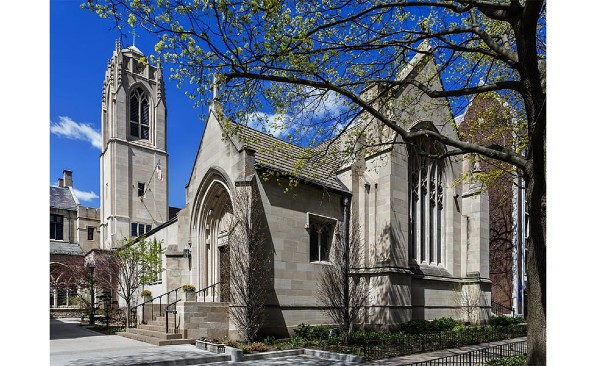By Burt Michaels, Class of 2019
“The carillon is the only instrument that summons its own audience,” claims Jim Fackenthal, carillonneur at St. Chrysostom’s Episcopal Church on North Dearborn Street, whose 1920s bell tower houses one of only two working carillons in Chicago. The other is at Rockefeller Chapel at the University of Chicago.

“You don’t prepare for a carillon concert,” he explains. “It comes to you. You’re just walking down the street or across campus. Suddenly these magical tones ring out, sounds no other instrument can produce. They wrest you out of the day you had in mind, to a more special place.”
“That’s why eminent composers, like Samuel Barber, have been drawn to composing music specifically for the carillon,” he suggests. “When we do our summer concert series, that’s the music we focus on. But we play other music too. Before and after church services, we play classical hymns. On
Halloween, we play music from The Exorcist. On Jewish holidays, we play Jewish folk songs.”
St. Chrysostom’s, inside and out, is a highlight of CAC’s North Dearborn Street tour. Its carillon has just been restored and expanded from 43 to 48 bells for full concert range. So, co-tour Director Virginia Gerst arranged for Fackenthal to lead the docents on a tour of the bell tower. Climbing flight after flight of increasingly steep, narrow, and twisting stairs proved challenging—but hearing an impromptu concert from inside the tower was worth it. Like drinking cask-strength whiskey: amazing once, but not something you’d do every day.
The bells range in size from about four feet in diameter, for the lowest tones, to about six inches for the highest. They’re perched at the top of the tower, above a big wooden keyboard. The bells don’t move.
Instead, big wooden clappers and pedals strike them, functioning like a piano’s keys and pedals. But the carillonneurs’ slapping and stomping the keyboard looks a lot more athletic than playing a piano.

Carillons date back to 17th century Belgium and the Netherlands. In the 1920s, American tourists brought them back here. Today there are six carillon players in Chicago and about 800 worldwide. “If you take one lesson on the carillon, you are immediately the 801st best carillon player in the world,” Fackenthal jests. “It’s a privilege to play these professionally,” he adds. “But you better have a day job, too.”
Architecturally, St. Chrysostom’s, on the National Register of Historic Places, has a beehive motif because, it is said, its eponym was so great an orator that words flowed from his mouth like honey.
Among the many community outreach efforts the very welcoming church undertakes is an annual Blessing of the Pets.
______________________________________________________________________________________________________________________________________

CLICK HERE for more stories on The Bridge.

